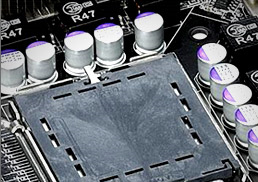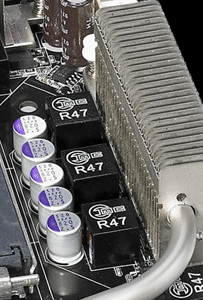Asus P5N32-SLI: Dual x16 - What Dreams Are Made On . . .
by Gary Key on October 27, 2005 12:05 AM EST- Posted in
- Motherboards
This line as spoken by the magician Prospero in William Shakespeare's whimsical play, "The Tempest", reminds us of the uniqueness of the human mind and the fleeting amount of time that we are around to utilize it."We are such stuff, As dreams are made on and our little life
Is rounded with a sleep..."
The Asus P5N32-SLI Deluxe that we will review today is also very unique in several ways and like most computer products in the current marketplace, its life span will be fleeting. However, for those of you who have the opportunity to utilize it, you will find what dreams are made on.
I will say this up front; this is one of the better motherboards that I have had the opportunity to use in the last 20 years. In fact, this board deserves additional testing time in order to explore fully and extract all of its performance potential. In keeping with what we believe is the best option for the current Intel processor lineup, the Pentium D series, we did not test a single core processor on this board. However, based upon the results that we extracted from the 840EE and 820D processors, we will be testing a single core processor on this board in the near future.
While it does not have the quad graphics capability of the Gigabyte GA-8N SLI Quad, the stellar layout of the MSI P4N Diamond, or the extensive feature set of the Gigabyte GA-8I955x Royal that was reviewed recently, this board's capability more than exceeds the sum of its parts. Yes, it does have some quirks as most products will, but Asus has engineered a truly remarkable motherboard utilizing the revised NVIDIA nForce4 Intel Edition SLI for the Northbridge and the NVIDIA nForce4 SLI for the Southbridge resulting in the x16 designation.


 |
 |
One of the main design features that Asus engineered into this board is an exclusive 8-phase voltage regulator power design that can significantly lower operating temperatures while reducing input ripple current and output ripple voltages . In fact, the input ripple current is over three times lower than a traditional 4-phase design while output ripple voltages are four times lower. The power consumption compared to the 4-phase design is about 10% less while the 8-phase design has the advantage of quicker transient responses and increased dependability due to lower thermal values.
What all this means is that your system will run cooler and overclock better compared to other solutions. In fact, through informal testing utilizing the BIOS readings, we found our Intel Pentium 840EE was on average running about 5c cooler in the Asus board compared to other solutions in the same test setup and ambient conditions. We will be conducting more thermal tests with scientific instrumentation in the near future. Our average overclocks were around 5% better than the other boards at more aggressive memory timings and with lower voltages required to the chipsets. While this does not sound like much, the ability of this board to run a CPU that previously topped out in the 3.9GHz range at up to 4.2GHz is impressive. The Asus P5N32-SLI Deluxe was an extremely stable board throughout our testing and did not fail a single time throughout two weeks of varying tests and conditions.
Let's see what this board is capable of now.










70 Comments
View All Comments
Kensei - Friday, October 28, 2005 - link
I just wanted to say that I REALLY appreciate the wonderful combination of a person who is a very, very good writer and technologist. This extremely rare combination makes him one of the best technical writers I've come across in the past 20 years.It's not too hard to find people who are technically competent but very hard to find someone who can communicate well and knows what the hell they're talking about (ask anyone who has been to college). Quite frankly, he sets a standard that I think all AnandTech writers (ok... all technical writers) should strive to eventually achieve. This level of expertise typically takes years of practice to acquire even among the talented. Can't wait for his next article.
To quote the first post..."Mixing philosophy, classical literature and computer hardware reviews? Gotta love it."
Kensei
Gary Key - Monday, October 31, 2005 - link
I greatly appreciate the comments. This was my third article and hopefully I improve with each one although you have now placed a great deal of pressure on me. ;->The next article series will be a multiple board review. I am learning how to convey several different messages in a very condensed form. It will be different than this last article so I would appreciate comments, good or bad. I try my best to listen to the readers and follow up on suggestions.
I have two very good editors in Wes and Karen so it really is a team effort at AnandTech. I still have a great deal to learn and in fact will be taking a composition course this winter to improve my skills.
Kensei - Thursday, November 3, 2005 - link
You are welcome. I don't think you need a composition course so I'd be interested in hearing how much you learned once it's over. Hopefully I'm wrong, but you may be disappointed by the course. If this is a college course, you may find that people in English departments don't quite get technical writing. It's different (although not totally different) than writing good short stories.Keep up the good work and I look forward to your future articles.
Kensei
screwtech02 - Friday, October 28, 2005 - link
So let me get this straight... In "theory" i can run my 820 at a 250fsb or 4.0, with a ddr700 rating?? And the board will recognize both the cores?? I'm tempted to get this board, but after having the previous one from ASUS, i'm scared to death, it was a HORRIBLE overclocker, max i could get was 230fsb, and lousey mem performance.... But if you say this board is different, i may try one....Gary Key - Saturday, October 29, 2005 - link
Email me please and I can forward some testing results to you along with additional information.NegativeEntropy - Friday, October 28, 2005 - link
Please check your USB/Firewire/Ethernet throughput graphs for their use of MB (MegaByte) vs Mb (Megabit).Nice board :)
Gary Key - Friday, October 28, 2005 - link
I have corrected the charts. Thank you for noticing the issue. Sometimes you view something so much that you miss the obvious. :)noac - Friday, October 28, 2005 - link
I read that you thought most would fit - "an excellent amount of room for alternative cooling solutions". Im wondering more specifically if the Scythe Ninja will fit with/without the optional fans. BTW did you test them, the fans? Wondering how much noise they make and if they work well.Gary Key - Friday, October 28, 2005 - link
I do not have the Ninja although I know where to get one for a test. :) I received the optional fans a couple of days ago from Asus (tried to get them before publishing but it did not work out). I will try them this weekend and respond to your questions. They are designed to be used with watercooling or phase change setups. The stock Intel 840EE cooler (upgraded from other Pentium D units) provided enough air flow in the area to keep the MOFSETs cool. The aftermarket coolers I used provided more than enough air flow and fit great within the CPU area. Let me know if you need a listing of these heatsinks.yacoub - Thursday, October 27, 2005 - link
That's a freakin' awesome (if expensive) board!Btw THANK YOU THANK YOU THANK YOU for finally showing just how greatly sound enabled impacts the framerates on boards with on-board audio. Amazing that 17-19% of your CPU's power can be sapped by a stupid audio chip, especially when that turns into ~15fps drop in some games. Ugh.